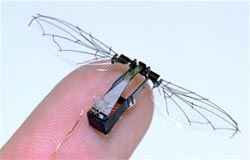Tiny MAVs May Someday Explore and Detect Environmental Hazards

Recent prototype of the Harvard Microrobotic Fly, a three-centimeter wingspan flapping-wing robot. (Credit: Ben Finio, The Harvard Microrobotics Lab)
His basic research is on track to evolve into robotic, insect-scale devices for monitoring and exploration of hazardous environments, such as collapsed structures, caves and chemical spills.
“We are developing a suite of capabilities which we hope will lead to MAVs that exceed the capabilities of existing small aircraft. The level of autonomy and mobility we seek has not been achieved before using robotic devices on the scale of insects,” said Wood.
Wood and his research team are trying to understand how wing design can impact performance for an insect-size, flapping-wing vehicle. Their insights will also influence how such agile devices are built, powered and controlled.
“A big emphasis of our AFOSR program is the experimental side of the work,” said Wood. “We have unique capabilities to create, flap and visualize wings at the scales and frequencies of actual insects.”
The researchers are constructing wings and moving them at high frequencies recreating trajectories similar to those of an insect. They are also able to measure multiple force components, and they can observe fluid flow around the wings flapping at more than 100 times per second.
Performing experiments at such a small scale presents significant engineering challenges beyond the study of the structure-function relationships for the wings.
“Our answer to the engineering challenges for these experiments and vehicles is a unique fabrication technique we have developed for creating wings, actuators, thorax and airframe at the scale of actual insects and evaluating them in fluid conditions appropriate for their scale,” he said.
They are also performing high-speed stereoscopic motion tracking, force measurements and flow visualization; the combination of which allows for a unique perspective on what is going on with these complex systems.
ABOUT AFOSR:
The Air Force Office of Scientific Research (AFOSR), located in Arlington, Virginia, continues to expand the horizon of scientific knowledge through its leadership and management of the Air Force's basic research program. As a vital component of the Air Force Research Laboratory (AFRL), AFOSR's mission is to discover, shape and champion basic science that profoundly impacts the future Air Force.
Media Contact
All latest news from the category: Power and Electrical Engineering
This topic covers issues related to energy generation, conversion, transportation and consumption and how the industry is addressing the challenge of energy efficiency in general.
innovations-report provides in-depth and informative reports and articles on subjects ranging from wind energy, fuel cell technology, solar energy, geothermal energy, petroleum, gas, nuclear engineering, alternative energy and energy efficiency to fusion, hydrogen and superconductor technologies.
Newest articles

Silicon Carbide Innovation Alliance to drive industrial-scale semiconductor work
Known for its ability to withstand extreme environments and high voltages, silicon carbide (SiC) is a semiconducting material made up of silicon and carbon atoms arranged into crystals that is…

New SPECT/CT technique shows impressive biomarker identification
…offers increased access for prostate cancer patients. A novel SPECT/CT acquisition method can accurately detect radiopharmaceutical biodistribution in a convenient manner for prostate cancer patients, opening the door for more…

How 3D printers can give robots a soft touch
Soft skin coverings and touch sensors have emerged as a promising feature for robots that are both safer and more intuitive for human interaction, but they are expensive and difficult…





















